Islamic Architecture
Islamic Architecture: From Characteristics to Modern Examples
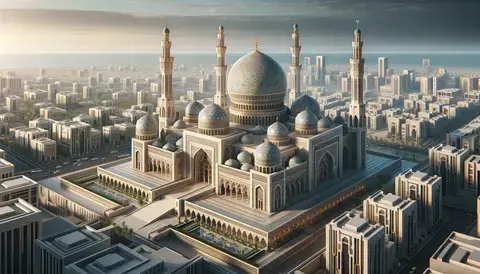
In this comprehensive new 2024 free course, we will study the captivating world of Islamic architecture, exploring its characteristics, iconic buildings, historical significance, and modern manifestations.
What Is Islamic Architecture?
Islamic architecture encompasses the architectural styles and building traditions associated with the Islamic world, influenced by the principles and aesthetics of Islam. It includes a diverse range of structures such as mosques, palaces, tombs, and fortifications, characterized by distinctive features and design elements that reflect Islamic culture, beliefs, and values.
Islamic architecture is a significant and influential style that has had a profound impact on the development of architecture in various parts of the world, including contributions to Western architecture. It's a style rich in history, art, and innovation.
Islamic Architecture Overview: Islamic architecture encompasses a wide range of styles and structures that have been influenced by the cultural and religious contexts of Islamic societies. It is known for its stunning beauty, intricate designs, and technological advancements, which have been adopted and adapted globally.
Cultural Importance of Islamic Architecture
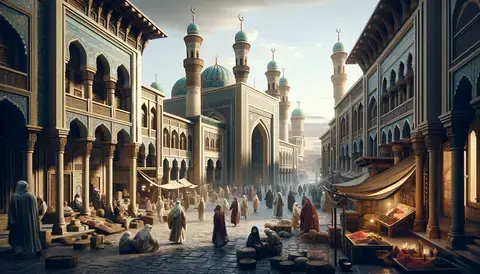
Islamic architecture is not only about the mosques; it also includes palaces, fortifications, educational institutions, and civic buildings, each contributing to the social and cultural fabric of Islamic societies.
The cultural importance of Islamic architecture extends beyond its aesthetic beauty and technical innovations, embodying a rich tapestry of historical, religious, and societal influences that have shaped civilizations across the globe. Here's an exploration of the profound cultural significance of Islamic architecture:
1. Religious Expression and Identity
Islamic architecture is deeply intertwined with the religious context in which it developed. Mosques, the most prominent type of Islamic architecture, are not just places of worship but also serve as community centers and places of learning. The architectural elements of mosques, such as minarets from which the call to prayer is made, mihrabs (prayer niches indicating the direction of Mecca), and spacious courtyards, are designed to meet both the spiritual and social needs of the Muslim community. These structures reflect the religious principles of Islam, emphasizing unity, order, and connection with the divine.
2. Symbolism and Artistry
Islamic architecture is renowned for its employment of intricate artistic details that carry rich symbolic meaning. Geometric patterns and arabesque designs found in Islamic buildings represent the infinite nature of Allah, reflecting the belief in the unity and order of the universe. The use of calligraphy, often featuring verses from the Quran, serves both an aesthetic and an educational purpose, reminding viewers of the teachings of Islam.
3. Technological Advancement and Innovation
Throughout history, Islamic architects and engineers have introduced innovative building techniques and materials that have significantly influenced architecture at a global scale. Techniques such as muqarnas (ornamental vaulting), the use of pointed arches, and complex dome constructions were not only structural achievements but also conveyed the sophistication of Islamic societies. These innovations have been adapted and integrated into various architectural styles beyond the Islamic world, including Renaissance and modern Western architecture.
4. Cultural Exchange and Adaptation
Islamic architecture reflects a remarkable adaptability to local cultural and environmental conditions. As Islam spread across different regions, Islamic architecture absorbed elements from local architectural traditions, leading to distinctive styles such as Moorish architecture in Spain, Mughal architecture in India, and Ottoman architecture in Turkey. This fusion of styles has resulted in a rich diversity within Islamic architecture, showcasing a unique blend of global influences.
5. Socio-Economic Impact
Islamic architecture also plays a significant role in the socio-economic context of the regions it dominates. Historical Islamic cities were planned around mosques and bazaars, facilitating not only religious practices but also trade and commerce. Palaces and fortresses manifest the power and wealth of Islamic rulers, while schools and libraries signify the emphasis on knowledge and education. The layout and structure of Islamic cities reflect a sophisticated understanding of social organization, urban planning, and environmental sustainability.
6. Legacy and Preservation
Today, many Islamic architectural sites are recognized as UNESCO World Heritage Sites, underscoring their universal value and importance to the collective cultural heritage of humanity. The preservation and study of these sites offer invaluable insights into the past civilizations, their ways of life, and their interactions with their environment and each other. The global appreciation and preservation efforts also highlight the ongoing relevance and admiration for Islamic architectural principles and aesthetics.
The cultural importance of Islamic architecture is manifested in its ability to convey religious ideals, incorporate artistic expression, advance architectural technology, and influence social structures. It remains a vital study of historical progress and cultural exchange, continuing to inspire and influence global architecture today.
Islamic Architecture History
Islamic architecture traces its roots to the early Islamic period, with influences from pre-Islamic civilizations such as Byzantine, Persian, and Roman. Over the centuries, it evolved and diversified, reflecting the cultural, political, and religious contexts of different regions and dynasties.
Islamic architecture has a rich and multifaceted history that spans centuries and encompasses a diverse range of influences, styles, and achievements. Let's delve deeper into the fascinating evolution of Islamic architecture:
Early Islamic Period: 7th - 10th centuries
Emergence of Islamic Architecture: Islamic architecture began to take shape following the rise of Islam in the Arabian Peninsula in the 7th century CE. Early Islamic buildings, such as the Prophet's Mosque in Medina and the Dome of the Rock in Jerusalem, reflected a synthesis of existing architectural traditions with new Islamic principles and aesthetics.
Influences from Pre-Islamic Civilizations: Islamic architecture drew inspiration from the architectural legacies of pre-Islamic civilizations, including Byzantine, Persian, and Roman. Elements such as domes, arches, and columnar motifs were adapted and reinterpreted within an Islamic framework.
Golden Age of Islamic Civilization: 8th - 14th centuries
Expansion and Patronage: The Islamic world witnessed a period of unprecedented expansion and cultural flourishing during the Abbasid, Umayyad, and Fatimid caliphates. Muslim rulers and dynasties patronized the construction of mosques, palaces, madrasas, and urban centers, leading to the development of distinctive regional architectural styles.
Regional Variations: Islamic architecture diversified across different regions, influenced by local geography, climate, culture, and building traditions. For example, the architecture of Al-Andalus (Islamic Spain) showcased a unique fusion of Islamic, Christian, and Jewish influences, while the Mamluk architecture of Egypt and Syria featured intricate stone carvings and ornamental details.
Mongol and Ottoman Periods: 13th - 17th centuries
Transitional Periods: The Mongol invasions and the rise of the Ottoman Empire brought about significant changes in Islamic architecture. Mongol conquests led to the spread of Islamic architectural styles to Central Asia and the Indian subcontinent, while Ottoman architecture synthesized Byzantine, Persian, and Islamic elements in monumental structures such as the Hagia Sophia in Istanbul.
Innovations and Grandeur: The Ottoman Empire, in particular, was known for its architectural innovations and grandiose building projects. Ottoman architects developed the distinctive Ottoman style characterized by monumental domes, slender minarets, and intricate tilework, exemplified by landmarks like the Suleymaniye Mosque and the Topkapi Palace.
Colonialism and Modernization: 18th - 20th centuries
Impact of Colonialism: Colonialism and Western influence had a profound impact on Islamic architecture in the 18th and 19th centuries. European colonial powers introduced new architectural styles and urban planning principles to Muslim-majority regions, leading to the hybridization of traditional Islamic architecture with Western elements.
Modernization and Revival: The 20th century saw efforts to modernize Islamic architecture while preserving its cultural heritage. Architects like Hassan Fathy in Egypt and Rifat Chadirji in Iraq sought to revive traditional building techniques and materials, promoting a synthesis of modernist principles with Islamic design sensibilities.
Islamic architecture has evolved over time, reflecting the dynamic interplay of cultural, political, and religious forces. From its early roots in the Islamic period to its diverse regional variations and encounters with other civilizations, Islamic architecture continues to inspire awe and admiration for its beauty, ingenuity, and cultural significance.
Key characteristics of Islamic architecture include:
Geometric Patterns: Islamic architecture is renowned for its intricate geometric patterns, which adorn surfaces such as walls, ceilings, and floors. These patterns, often derived from mathematical principles, symbolize the order and unity of the universe in Islamic cosmology.
Arches and Domes: Arches and domes are prominent architectural elements in Islamic buildings, symbolizing grandeur, spirituality, and the heavens. Arches may be rounded or pointed, while domes may be bulbous or onion-shaped, depending on regional variations.
Calligraphy and Ornamentation: Arabic calligraphy is a central feature of Islamic architecture, with Quranic verses and religious inscriptions adorning walls, arches, and domes. Ornamental motifs such as arabesques, vegetal designs, and geometric carvings embellish facades and interiors, adding richness and beauty to architectural spaces.
Courtyards and Gardens: Courtyards and gardens play an essential role in Islamic architecture, serving as tranquil spaces for prayer, contemplation, and social gatherings. Courtyards often feature fountains, pools, and lush vegetation, creating a sense of serenity and harmony with nature.
Minarets: Tall spires typically associated with mosques, from which the call to prayer is announced.
Water Features: Water plays a crucial role in Islamic architecture, symbolizing paradise and used for practical purposes like cooling and ceremonial washings.
Islamic Architecture Buildings
Types of Islamic Architecture
Islamic architecture encompasses various types and styles, including:
- Mosques: Places of worship for Muslims, mosques vary in size and design, ranging from simple prayer halls to elaborate complexes with minarets and domes.
- Palaces: Palatial complexes served as seats of power for rulers and aristocrats, featuring luxurious residences, audience halls, and ornamental gardens.
- Tombs and Mausoleums: These sacred structures honor religious figures, rulers, and dignitaries, often adorned with intricate decoration and architectural embellishments.
- Fortifications: Defensive structures such as citadels and city walls protected cities and territories, featuring sturdy walls, towers, and gates.
From majestic mosques to opulent palaces, Islamic architecture encompasses a diverse range of buildings, including:
Famous Islamic Architecture
The world is replete with famous examples of Islamic architecture, from the grandeur of the Hagia Sophia in Istanbul to the tranquility of the Blue Mosque. Each landmark reflects the cultural, religious, and artistic achievements of its time, leaving an indelible mark on the architectural landscape.
- Great Mosque of Cordoba: A masterpiece of Moorish architecture in Spain, featuring a stunning prayer hall with horseshoe arches and intricate decorative motifs.
- Taj Mahal: A UNESCO World Heritage site in India, renowned for its exquisite marble facade, symmetrical gardens, and elegant domes—a testament to Mughal architectural splendor.
- Alhambra Palace: A medieval fortress and palace complex in Granada, Spain, showcasing the pinnacle of Nasrid architecture with its intricate stucco decoration and tranquil courtyards.
- Sheikh Zayed Grand Mosque: Located in Abu Dhabi, UAE, this modern marvel of Islamic architecture boasts intricate marble mosaic patterns, gleaming domes, and the world's largest hand-knotted carpet.
Indo-Islamic Architecture History & Examples
Indo-Islamic architecture refers to the architectural style that emerged in the Indian subcontinent during the medieval period, blending Islamic design principles with indigenous architectural traditions. Here are examples of Indo-Islamic architecture along with their historical context:
Qutub Minar, Delhi:
- History: Built in the early 13th century by Qutb al-Din Aibak, the first ruler of the Delhi Sultanate, the Qutub Minar is one of the earliest and most iconic examples of Indo-Islamic architecture in India. It was initially constructed as a victory tower to commemorate the victory of Muslim forces over Hindu rulers.
- Architecture: The Qutub Minar is a towering minaret made of red sandstone and marble, standing at a height of over 72 meters. It features intricate calligraphy, geometric patterns, and Quranic inscriptions, showcasing the fusion of Islamic and Indian architectural styles.
Taj Mahal, Agra:
- History: Built in the 17th century by the Mughal emperor Shah Jahan, the Taj Mahal is perhaps the most renowned example of Indo-Islamic architecture. It was commissioned as a mausoleum for Shah Jahan's wife, Mumtaz Mahal, and is considered one of the world's most beautiful architectural masterpieces.
- Architecture: The Taj Mahal is characterized by its symmetrical design, white marble facade, and exquisite decorative elements such as intricate carvings, inlaid gemstones, and ornamental gardens. Its architecture reflects a synthesis of Persian, Indian, and Islamic influences, symbolizing the pinnacle of Mughal architectural achievement.
Fatehpur Sikri, Uttar Pradesh:
- History: Built in the late 16th century by Emperor Akbar, Fatehpur Sikri served as the capital of the Mughal Empire for a brief period before being abandoned due to water scarcity. It is renowned for its architectural grandeur and cultural significance as a UNESCO World Heritage site.
- Architecture: Fatehpur Sikri boasts a rich collection of Indo-Islamic architectural wonders, including the Jama Masjid mosque, the Buland Darwaza (Victory Gate), and the exquisite palaces of Akbar's court. The architecture combines elements of Persian, Indian, and Islamic styles, showcasing the eclectic tastes of the Mughal rulers.
Humayun's Tomb, Delhi:
- History: Constructed in the 16th century during the reign of Emperor Humayun, this mausoleum is one of the earliest examples of Mughal architecture in India. It was commissioned by Humayun's widow, Empress Bega Begum, and served as the inspiration for the design of the Taj Mahal.
- Architecture: Humayun's Tomb is characterized by its symmetrical layout, red sandstone facade, and intricate marble lattice work. The tomb stands within a Charbagh garden layout, a traditional Persian-inspired design, reflecting the fusion of Persian and Indian architectural influences.
Lalbagh Fort, Dhaka:
- History: Constructed in the 17th century by Prince Muhammad Azam, the son of Mughal Emperor Aurangzeb, Lalbagh Fort is a prominent example of Indo-Islamic architecture in Bangladesh. The fort remained incomplete due to the premature death of Prince Azam, but it stands as a testament to the Mughal architectural legacy in the region.
- Architecture: Lalbagh Fort features a blend of Mughal, Persian, and Bengali architectural elements, including mosques, audience halls, and ornamental gateways. The fort's design incorporates red brick walls, arched gateways, and decorative tilework, reflecting the architectural style of the Mughal period.
These examples highlight the rich diversity and cultural significance of Indo-Islamic architecture, which continues to inspire awe and admiration for its beauty, craftsmanship, and historical legacy in the Indian subcontinent.
Modern Islamic Architecture
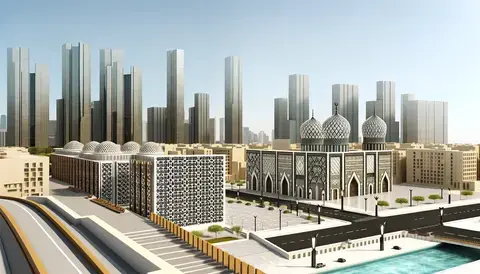
Contemporary architects continue to draw inspiration from Islamic architectural traditions, blending traditional elements with modern design principles to create innovative structures. From skyscrapers in the Middle East to cultural centers in Europe, modern Islamic architecture reflects the dynamism and creativity of the Muslim world today.
Modern Islamic Architecture: Blending Tradition with Innovation
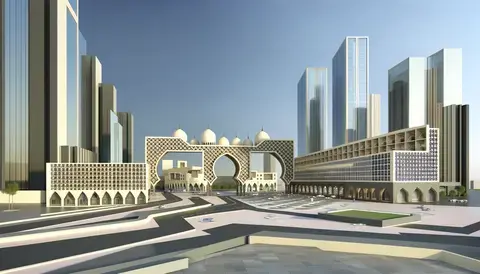
In the contemporary era, architects around the world are reimagining Islamic architectural traditions, infusing them with modern design principles to create innovative and visually striking structures. Here, we explore the evolution of modern Islamic architecture through examples of iconic buildings from various regions:
Burj Khalifa, Dubai:
- Architectural Innovation: Designed by Adrian Smith of Skidmore, Owings & Merrill, the Burj Khalifa stands as the tallest building in the world, soaring to a height of over 828 meters. Its sleek and futuristic design incorporates Islamic architectural motifs such as geometric patterns and arabesques, paying homage to the region's cultural heritage while embracing cutting-edge technology and engineering.
King Abdulaziz Center for World Culture, Saudi Arabia:
- Cultural Icon: Designed by the Norwegian architectural firm Snøhetta, the King Abdulaziz Center for World Culture, also known as Ithra, is a cultural complex in Dhahran, Saudi Arabia. Its distinctive geometric form and shimmering facade are inspired by the traditional Islamic pattern of the 'mashrabiya,' a latticed screen used for privacy and ventilation in Islamic architecture.
Museum of Islamic Art, Qatar:
- Architectural Elegance: Designed by the legendary architect I. M. Pei, the Museum of Islamic Art in Doha, Qatar, is a masterpiece of modern Islamic architecture. Its geometrically inspired design features a cubic structure topped with a central dome, evoking the grandeur of Islamic architectural heritage while showcasing a contemporary aesthetic.
The Shard, London:
- Global Influence: Designed by Renzo Piano, The Shard is a towering skyscraper in London that incorporates elements of Islamic architectural tradition into its design. Its tapered form and faceted glass facade draw inspiration from the minaret-like structures found in Islamic architecture, symbolizing a fusion of cultural influences in a global city.
Bahrain National Museum, Bahrain:
- Cultural Showcase: Designed by Gordon Murray and Alan Stanton, the Bahrain National Museum in Manama is a cultural institution that celebrates the rich heritage of Bahrain and the wider Islamic world. Its modernist design features a series of interconnected pavilions inspired by traditional Arabian architecture, creating a dynamic and inviting space for visitors.
Qatar National Library, Qatar:
- Architectural Splendor: Designed by Dutch architect Rem Koolhaas, the Qatar National Library in Doha is a striking example of modern Islamic architecture. Its futuristic design incorporates elements of traditional Islamic architecture, such as geometric patterns and mashrabiya screens, while embracing contemporary materials and technology.
Islamic Cultural Centre of New York, USA:
- Community Hub: Designed by Skidmore, Owings & Merrill, the Islamic Cultural Centre of New York serves as a vibrant hub for the Muslim community in the heart of Manhattan. Its modernist design features a soaring minaret, a domed prayer hall, and intricate decorative motifs, reflecting the cultural and religious identity of its users while embracing the spirit of cosmopolitanism.
These examples showcase the diverse and dynamic nature of modern Islamic architecture, which continues to evolve and inspire architects and designers around the world. By blending traditional elements with contemporary aesthetics and technologies, modern Islamic architecture reflects the cultural vitality and creative ingenuity of the Muslim world in the 21st century.
Influence of Islamic Architecture on Global and European Architectural Styles
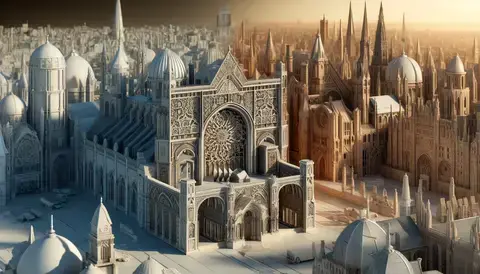
Islamic Architecture Historical Influence
Islamic architecture has exerted a profound influence on architectural styles worldwide, shaping the built environment across diverse cultures and civilizations. Let's explore its impact on global architecture as well as its specific influence on European architectural styles, with a focus on the Gothic architectural style.
Global Influence of Islamic Architecture
Islamic architecture has left an indelible mark on global architectural styles, influencing design principles, construction techniques, and decorative motifs in various regions:
Asia: In regions such as the Indian subcontinent and Southeast Asia, Islamic architecture has influenced the design of mosques, palaces, and tombs, blending with indigenous architectural traditions to create unique structures like the Taj Mahal in India and the Sultan Ahmed Mosque in Turkey.
Africa: Islamic architecture has flourished in North Africa and the Sahel region, where it has shaped the design of mosques, madrasas, and urban centers. Landmarks such as the Great Mosque of Djenné in Mali showcase the distinctive mud-brick architecture of the region, influenced by Islamic design principles.
Middle East: Islamic architecture has reached its zenith in the Middle East, with iconic structures like the Dome of the Rock in Jerusalem and the Sheikh Zayed Grand Mosque in Abu Dhabi reflecting the region's architectural splendor and cultural heritage.
Americas: Islamic architectural elements have been incorporated into buildings in the Americas, particularly in regions with significant Muslim populations. Examples include mosques, cultural centers, and residential buildings that feature Islamic motifs and design elements.
Influence of Islamic Architecture on European Gothic Architecture
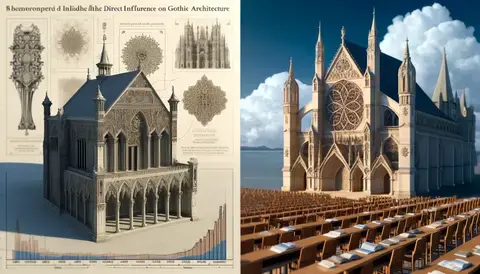
The Gothic architectural style, synonymous with the soaring cathedrals and majestic churches of medieval Europe, bears traces of influence from Islamic architecture:
Arches and Pointed Vaults: Islamic architecture introduced Europeans to the concept of pointed arches and ribbed vaulting, which enabled the construction of taller and more spacious interiors in Gothic cathedrals such as Notre-Dame de Paris and Chartres Cathedral.
Decorative Motifs and Ornamentation: Arabesque patterns, geometric designs, and intricate calligraphy, characteristic of Islamic architecture, inspired the decorative motifs and ornamentation found in Gothic buildings. The use of stone tracery and stained glass windows reflects the influence of Islamic craftsmanship.
Cultural Exchange and Transmission of Knowledge: The Crusades and cultural interactions between Europe and the Islamic world facilitated the exchange of architectural ideas and techniques. European architects and builders drew inspiration from Islamic architecture encountered during their travels to the Holy Land and Moorish Spain.
Structural Innovations and Engineering: Islamic architects were pioneers in structural engineering, developing techniques such as ribbed vaulting and flying buttresses. These innovations, adopted by European builders, revolutionized Gothic architecture and enabled the construction of monumental cathedrals and churches.
Islamic architecture has had a far-reaching impact on global architectural styles, influencing design, construction, and ornamentation across continents. Its specific influence on European Gothic architecture highlights the interconnectedness of civilizations and the enduring legacy of cross-cultural exchange in shaping the architectural heritage of humanity.
Overall, Islamic architecture is characterized by its emphasis on geometric design, harmonious proportions, and spiritual symbolism, reflecting the cultural and religious values of the Muslim world. It encompasses a rich and diverse heritage, spanning centuries and continents, and continues to inspire architects, artists, and scholars around the globe.
A list that Covers the breadth of Islamic architecture.
General Categories of Islamic Architecture:
Historical Periods and Styles
- Ancient Islamic Architecture
- Early Islamic Architecture
- Abbasid Architecture
- Umayyad Architecture
- Fatimid Architecture
- Mamluk Architecture
- Ottoman Islamic Architecture
- Indo-Islamic Architecture
- Moorish Architecture
- Persian Islamic Architecture
Modern and Contemporary Islamic Architecture
- Contemporary Islamic Architecture
- Modern Islamic Buildings
- Futuristic Islamic Architecture
- Neo-Islamic Architecture
Specific Architectural Elements and Designs
- Islamic Arch Design (Horseshoe, Multifoil, Ogee)
- Mihrab, Minbar, and Mehrab Designs
- Masjid Architecture (including interior and exterior design)
- Islamic Geometric Architecture
- Islamic Calligraphy in Architecture
Specific Buildings and Structures
- Qutub Minar Architectural Features
- Mosque of Islamic Architecture (e.g., Masjid Al-Haram, Masjid an-Nabawi)
- Islamic Cultural Centers
- Islamic Educational Buildings (e.g., Madrasas)
Regional Variations
- Arabian Islamic Architecture
- Chinese Islamic Architecture
- Spanish Islamic Architecture (Andalusian)
- Western Islamic Architecture
Miscellaneous Topics in Islamic Architecture
- History of Islamic Architecture
- Islamic Art and Architecture Integration
- Role of Color and Symbolism in Islamic Architecture
- Islamic Urban Design and Landscape Architecture
Prominent Figures and Institutions
- Famous Islamic Architects
- Aga Khan Museum Architecture
- Architectural Contributions by Zaha Hadid in Islamic Contexts
Questions and Answers FAQs
Islamic Architecture FAQs:
1. What is the difference between Arabic and Islamic architecture? Arabic architecture refers to the architectural traditions of the Arab world, while Islamic architecture encompasses buildings influenced by Islamic principles and aesthetics, regardless of the cultural or ethnic background of the builders.
2. What are the main types of Islamic architecture? Islamic architecture primarily comprises mosques, palaces, tombs and mausoleums, and fortifications. Each type serves specific functions and showcases distinct architectural features.
4. How has Islam influenced architecture? Islam has significantly influenced architecture through its emphasis on geometric patterns, calligraphy, and architectural elements such as arches and domes. Examples include the intricate designs of mosques and the symbolism embedded in Islamic architectural features.
5. What are the main features of Arab culture architecture? Arab architecture showcases features such as courtyard houses, wind towers for natural ventilation, and decorative motifs inspired by Islamic art. These elements are influenced by the geography, climate, and cultural heritage of the Arab world.
6. Why is Islamic architecture important? Islamic architecture holds cultural, historical, and artistic significance. It reflects the rich heritage of Islamic civilization, embodies Islamic values, and serves as a source of inspiration for architects worldwide.
7. What are some major principles of Islamic architecture? Major principles include harmony, balance, functionalism, attention to detail, and the use of geometric patterns and symbolism. Islamic architecture aims to create spaces that inspire spirituality and reflection.
8. How does Islamic architecture integrate religious symbolism? Islamic architecture incorporates religious symbolism through geometric patterns representing unity, calligraphy displaying Quranic verses, and architectural features symbolizing spiritual concepts, such as the mihrab indicating the direction of prayer.
9. What challenges exist in preserving Islamic architectural heritage? Preserving Islamic architectural heritage faces challenges like urban development, environmental degradation, political instability, and insufficient funding for conservation efforts.
10. Where can individuals find more information on Islamic architecture? Explore resources in libraries, museums, academic institutions, and online platforms for extensive literature, exhibitions, courses, and virtual tours on Islamic architecture. Dive deeper into the fascinating world of Islamic architecture and its enduring legacy.
11. What are 10 Distinctive Elements of Islamic Architecture? Islamic architecture boasts numerous distinctive elements, including intricate geometric patterns, arches and domes, calligraphy, ornamental motifs, courtyards and gardens, minarets, mihrabs, mosaics and tilework, mashrabiya screens, and water features. These elements contribute to the unique beauty and symbolism of Islamic architecture.
Islamic architecture is characterized by a rich array of distinctive elements that reflect the cultural, religious, and artistic traditions of the Muslim world. Here are 10 key features that define Islamic architecture:
Geometric Patterns: Intricate geometric patterns adorn the surfaces of Islamic buildings, including walls, ceilings, and floors. These patterns, often based on mathematical principles, symbolize the order and unity of the universe in Islamic cosmology.
Arches and Domes: Arches and domes are prominent architectural elements in Islamic buildings, serving both structural and symbolic functions. Arches may be rounded or pointed, while domes may be bulbous or onion-shaped, depending on regional variations.
Calligraphy: Arabic calligraphy is a central feature of Islamic architecture, with Quranic verses, religious inscriptions, and poetic texts often integrated into architectural designs. Calligraphy serves as a visual expression of Islamic beliefs and values, adding a spiritual dimension to architectural spaces.
Ornamental Motifs: Islamic architecture is known for its rich repertoire of ornamental motifs, including arabesques, vegetal designs, and geometric carvings. These motifs adorn facades, doorways, and interior spaces, creating a sense of beauty and elegance.
Courtyards and Gardens: Courtyards and gardens are integral components of Islamic architecture, providing serene and contemplative spaces within buildings. Courtyards often feature fountains, pools, and lush vegetation, offering respite from the hustle and bustle of urban life.
Minarets: Minarets are tall, slender towers typically found adjacent to mosques, from which the call to prayer (adhan) is proclaimed. Minarets may feature intricate decorative elements and serve as landmarks within the urban landscape.
Mihrab: The mihrab is a niche or alcove in the wall of a mosque that indicates the direction of prayer (qibla) towards Mecca. Mihrabs are often elaborately decorated with geometric patterns, calligraphy, and ornamental motifs, emphasizing the spiritual focal point of the prayer space.
Mosaics and Tilework: Mosaics and tilework are commonly used in Islamic architecture to embellish surfaces and create visually stunning decorative effects. Tiles may feature vibrant colors, intricate patterns, and geometric designs, adding vibrancy and depth to architectural spaces.
Mashrabiya: Mashrabiya is a type of latticed or carved wooden screen found in Islamic architecture, particularly in the Middle East and North Africa. Mashrabiya screens are used to provide privacy, shade, and ventilation while allowing airflow and diffused light to enter interior spaces.
Water Features: Water features such as fountains, pools, and reflecting basins are ubiquitous in Islamic architecture, symbolizing purity, abundance, and life-giving properties. Water elements serve both functional and symbolic purposes, enhancing the aesthetic and sensory experience of architectural environments.
These distinctive elements collectively contribute to the unique character and beauty of Islamic architecture, reflecting the diverse cultural heritage and spiritual traditions of the Muslim world.
For additional details and a comprehensive collection of questions and answers regarding Islam and architecture, please follow this link.
Discover more → Islamic Architecture FAQs
Islamic Architecture PDF
For those seeking in-depth knowledge of Islamic architecture, numerous PDF resources are available online, offering insights into its history, principles, and cultural significance. Explore scholarly articles, architectural journals, and academic publications to deepen your understanding of this fascinating subject.
Explore Further
More about the world of Islamic architecture with these related topics:
- The Influence of Arab Culture on Western Architecture: Lessons on Its Global Influence
- Islamic Architecture Symbols: Uncover the symbolic meanings behind the geometric patterns, calligraphy, and decorative motifs found in Islamic architecture.
- Islamic Architecture vs. Western Architecture: Compare and contrast the architectural styles, techniques, and cultural influences of Islamic and Western architecture.
- Islamic Architecture Books: Discover recommended books and resources for exploring the history, theory, and practice of Islamic architecture.
